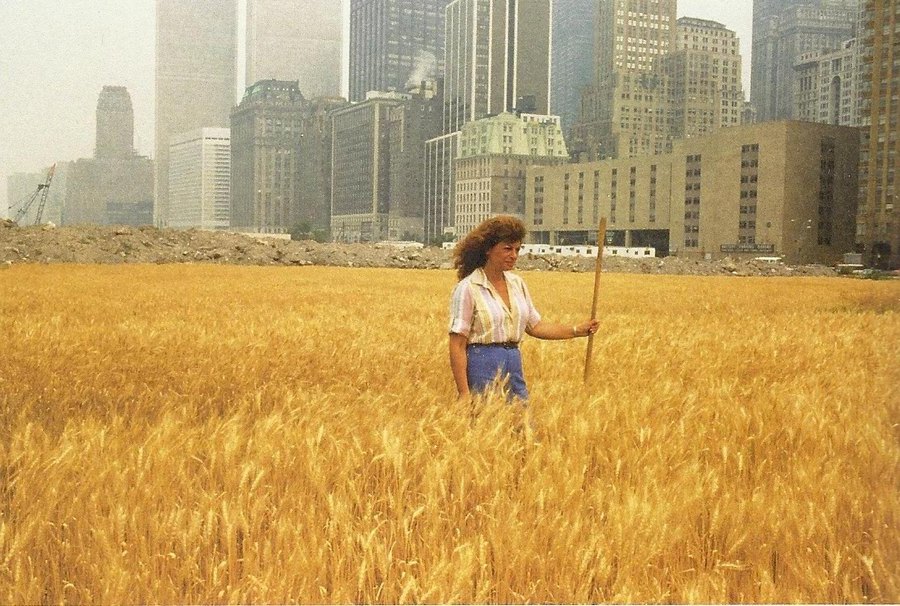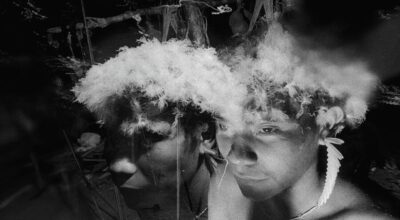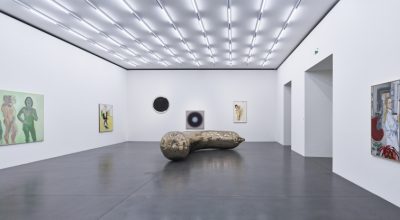
Agnes Denes, Wheatfield—A Confrontation. Two acres of wheat planted and harvested by the artist on the Battery Park landfill, Manhattan, Summer 1982. Commissioned by Public Art Fund. Photo by John McGrall. Courtesy the artist and Leslie Tonkonow Artworks + Projects.
Agnes Denes:a Pioneer of Conceptual And Environmental Art
[et_pb_section bb_built=»1″][et_pb_row][et_pb_column type=»4_4″][et_pb_text _builder_version=»3.2.2″]
The Shed presents the most comprehensive retrospective exhibition to date of the work of Agnes Denes (b. 1931), a leading figure in Conceptual and Environmental art. Agnes Denes: Absolutes and Intermediates brings together more than 150 works in a broad range of media spanning Denes’s 50-year career, including three new works commissioned by The Shed.
Denes rose to international attention in the 1960s and 1970s, creating work influenced by science, mathematics, philosophy, linguistics, ecology, and psychology to analyze, document, and ultimately aid humanity. Her theories about climate change and life in an ever-changing, technologically-driven world demonstrate a deeply prescient understanding of society today.
“Agnes Denes was ahead of her time. She saw the coming of an ecological crisis, and in the 1960s started working with land, mathematics, philosophy, language, and technology to consider and offer solutions to the challenges facing humanity,” said Emma Enderby, Senior Curator of The Shed. “She alerted us to humanitarian and environmental issues through beautiful, sensual visual forms combined with a deeply researched and scholarly philosophy. Her vision was radical, and in retrospect, terrifyingly prophetic.”
[/et_pb_text][et_pb_image _builder_version=»3.2.2″ src=»https://artishockrevista.com/wp-content/uploads/2020/01/191008_TheShed_023.jpg» show_in_lightbox=»on» align=»center» alt=»Installation view of “Agnes Denes: Absolutes and Intermediates”, The Shed, New York. October 9, 2019 – March 22, 2020. Photo: Scott Rudd Events.» title_text=»Installation view of “Agnes Denes: Absolutes and Intermediates”, The Shed, New York. October 9, 2019 – March 22, 2020. Photo: Scott Rudd Events.» /][et_pb_image _builder_version=»3.2.2″ src=»https://artishockrevista.com/wp-content/uploads/2020/01/191008_TheShed_027.jpg» show_in_lightbox=»on» align=»center» alt=»Installation view of “Agnes Denes: Absolutes and Intermediates”, The Shed, New York. October 9, 2019 – March 22, 2020. Photo: Scott Rudd Events.» title_text=»Installation view of “Agnes Denes: Absolutes and Intermediates”, The Shed, New York. October 9, 2019 – March 22, 2020. Photo: Scott Rudd Events.» /][et_pb_text _builder_version=»3.2.2″]
Highlights of Agnes Denes: Absolutes and Intermediates include selections from her drawing series, which began in the late 1960s: the “Philosophical Drawings”, “Isometric Systems in Isotropic Space—Map Projections,” and “Pyramid Series,” the eco-conscious sculpture Pyramids of Conscience (2005); documentation of her realized monumental public works, including the iconic Wheatfield—A Confrontation (1982), which transformed the land that became New York’s Battery Park City into a two-acre wheat field; and a presentation of unrealized works, including three models commissioned by The Shed that expound and expand on ideas that have been ever-present throughout Denes’s career.
“Agnes Denes not only anticipated the man-made destruction of natural habitats at a moment when few people were paying attention, but much of her work features solutions to ecological crises that we are now facing,” said Hans Ulrich Obrist, The Shed’s senior program advisor. “Her preparatory drawings and plans are amazingly detailed and aesthetically beautiful. A Model for A Forest for New York is one such unrealized monumental project that this exhibition helps to advance to the next level, to help further a visionary idea that she has been developing throughout her career.”
[/et_pb_text][et_pb_image _builder_version=»3.2.2″ src=»https://artishockrevista.com/wp-content/uploads/2020/01/191008_TheShed_031.jpg» show_in_lightbox=»on» align=»center» alt=»Installation view of “Agnes Denes: Absolutes and Intermediates”, The Shed, New York. October 9, 2019 – March 22, 2020. Photo: Scott Rudd Events.» title_text=»Installation view of “Agnes Denes: Absolutes and Intermediates”, The Shed, New York. October 9, 2019 – March 22, 2020. Photo: Scott Rudd Events.» /][et_pb_image _builder_version=»3.2.2″ src=»https://artishockrevista.com/wp-content/uploads/2020/01/191008_TheShed_014.jpg» show_in_lightbox=»on» align=»center» alt=»Installation view of “Agnes Denes: Absolutes and Intermediates”, The Shed, New York. October 9, 2019 – March 22, 2020. Photo: Scott Rudd Events.» title_text=»Installation view of “Agnes Denes: Absolutes and Intermediates”, The Shed, New York. October 9, 2019 – March 22, 2020. Photo: Scott Rudd Events.» /][et_pb_image _builder_version=»3.2.2″ src=»https://artishockrevista.com/wp-content/uploads/2020/01/191008_TheShed_017.jpg» show_in_lightbox=»on» align=»center» alt=»Installation view of “Agnes Denes: Absolutes and Intermediates”, The Shed, New York. October 9, 2019 – March 22, 2020. Photo: Scott Rudd Events.» title_text=»Installation view of “Agnes Denes: Absolutes and Intermediates”, The Shed, New York. October 9, 2019 – March 22, 2020. Photo: Scott Rudd Events.» /][et_pb_text _builder_version=»3.2.2″]
The exhibition is organized into the main groupings of Denes’s work throughout her career: drawings, sculptures, monumental public works, and unrealized projects. Denes envisioned the “Philosophical Drawings” as ways to “visualize knowledge… [which] wasn’t easy, because I tried to visualize things that have never been visualized before, like logic, mathematics, thinking processes, and so on.”
Examples on view include Dialectic Triangulation: A Visual Philosophy (1983), which analyzes and visualizes humanity’s achievements, paradoxes, and follies in a highly complex blueprint, including factors like ethics, logic, emotions and passions, and astronomy. In her “Map Projections,” Denes represents the Earth in a technical sketch, maintaining the planet’s dimensions but reforming it as a cube, a snail, and a hot dog, among other shapes.
Denes’s “Pyramid Series” uses beautifully detailed drawings employing mathematical theory to create shifting pyramid forms that address environmental and philosophical concepts. The series also includes a group of drawings under the title “Future City,” jewel-like works that are actual plans for future cities to cope with impending ecological stress, including space stations and a floating city that supports life on or under water. Denes explores the pyramid form in sculpture as well, as in the four-part Pyramids of Conscience (2005): three Plexiglas pyramids are filled with clean water, polluted water, or crude oil, and the fourth has a mirrored surface to reflect viewers and their complicity in environmental issues.
Denes is best known for her monumental public artwork Wheatfield—A Confrontation (1982), which featured a two-acre wheat field planted on the land which became New York’s Battery Park City as a comment on mismanagement of world hunger, food, waste, energy, commerce, trade, land use, and economics. Photographs and other documentation of Wheatfield are on view, as well as of other public works such as Rice/Tree/Burial, thought to be the first-ever site-specific work with ecological concerns, in which Denes planted rice, chained trees, and buried haiku poetry in Sullivan County, NY (1968) and later at Artpark, Lewiston (1977 – 79); and Tree Mountain – A Living Time Capsule—11,000 Trees, 11,000 People, 400 Years (1992 – 96), a planting of 11,000 trees in Finland in the pattern of the golden ratio.
[/et_pb_text][et_pb_image _builder_version=»3.2.2″ src=»https://artishockrevista.com/wp-content/uploads/2020/01/AgnesDenes-wheatfield-more-than-green1.jpg» show_in_lightbox=»on» align=»center» alt=»Agnes Denes, Wheatfield—A Confrontation. Two acres of wheat planted and harvested by the artist on the Battery Park landfill, Manhattan, Summer 1982. Commissioned by Public Art Fund. Photo by John McGrall. Courtesy the artist and Leslie Tonkonow Artworks + Projects.» title_text=»Agnes Denes, Wheatfield—A Confrontation. Two acres of wheat planted and harvested by the artist on the Battery Park landfill, Manhattan, Summer 1982. Commissioned by Public Art Fund. Photo by John McGrall. Courtesy the artist and Leslie Tonkonow Artworks + Projects.» /][et_pb_text _builder_version=»3.2.2″]
The exhibition debuts three new Shed commissions of works that feature ideas and themes that Denes has explored throughout her career. A Forest for New York (2014–ongoing) is a proposal by Denes to turn a 120-acre landfill in Far Rockaway, Queens, into a park for all New Yorkers, planting 100,000 trees to help address respiratory health issues in the area and turn a barren space into a thriving forest. The Shed commissioned a model of the park to illustrate Denes’s continued cultural and environmental vision. Model for Probability Pyramid—Study for Crystal Pyramid (2019) is a variation of a 1976 drawing of a monumental, theoretical superstructure that would measure 50 by 50 meters and be constructed from 160,000 glass blocks. For this exhibition, The Shed commissioned a variation of the pyramid that measures 22.5 feet long by 30 feet wide by 17 feet high, comprised of nearly 6,000 3-D printed bricks made of compostable corn-based plastic, and is illuminated from within.
The Shed also commissioned Model for Teardrop—Monument to Being Earthbound (2019), a working proposal for a future monument featuring a 3-D printed teardrop floating above its base, kept in place by a magnetic field and glowing like a candle, as Denes proposed in her original 1984 drawing.
A scholarly publication accompanies the exhibition, edited by Emma Enderby and featuring a conversation between Agnes Denes and Hans Ulrich Obrist, as well as essays by Enderby, Giampaolo Bianconi, Lynn Gamwell, Renee Gladman, Caroline A. Jones, Lucy R. Lippard, Timothy Morton, and Klaus Ottmann.
[/et_pb_text][et_pb_image _builder_version=»3.2.2″ src=»https://artishockrevista.com/wp-content/uploads/2020/01/191008_TheShed_019.jpg» show_in_lightbox=»on» align=»center» alt=»Installation view of “Agnes Denes: Absolutes and Intermediates”, The Shed, New York. October 9, 2019 – March 22, 2020. Photo: Scott Rudd Events.» title_text=»Installation view of “Agnes Denes: Absolutes and Intermediates”, The Shed, New York. October 9, 2019 – March 22, 2020. Photo: Scott Rudd Events.» /][et_pb_image _builder_version=»3.2.2″ src=»https://artishockrevista.com/wp-content/uploads/2020/01/191008_TheShed_RUSH_002.jpg» show_in_lightbox=»on» align=»center» alt=»Installation view of “Agnes Denes: Absolutes and Intermediates”, The Shed, New York. October 9, 2019 – March 22, 2020. Photo: Scott Rudd Events.» title_text=»Installation view of “Agnes Denes: Absolutes and Intermediates”, The Shed, New York. October 9, 2019 – March 22, 2020. Photo: Scott Rudd Events.» /][et_pb_text _builder_version=»3.2.2″]
Agnes Denes: Absolutes and Intermediates is on view at The Shed (545 West, 30th Street, New York, NY) until March 22, 2020. Featured Image: Agnes Denes, Wheatfield—A Confrontation. Two acres of wheat planted and harvested by the artist on the Battery Park landfill, Manhattan, Summer 1982. Commissioned by Public Art Fund. Photo by John McGrall. Courtesy the artist and Leslie Tonkonow Artworks + Projects. [/et_pb_text][/et_pb_column][/et_pb_row][/et_pb_section]
Agnes Denes: Absolutes and Intermediates is on view at The Shed (545 West, 30th Street, New York, NY) until March 22, 2020. Featured Image: Agnes Denes, Wheatfield—A Confrontation. Two acres of wheat planted and harvested by the artist on the Battery Park landfill, Manhattan, Summer 1982. Commissioned by Public Art Fund. Photo by John McGrall. Courtesy the artist and Leslie Tonkonow Artworks + Projects. [/et_pb_text][/et_pb_column][/et_pb_row][/et_pb_section]
También te puede interesar
THE YANOMAMI STRUGGLE
Esta exposición, curada por Thyago Nogueira, reúne 200 fotografías de Claudia Andujar junto a más de 80 dibujos y pinturas hechas por artistas Yanomami. Se trata de la mayor muestra de arte Yanomami en...
A Woman Looking at Men Looking at Women
The themes of the exhibition address several issues central to feminist theory, moving from conventions of female representation through sexual emancipation to the challenging and subversion of traditional gender roles. Artists include Magdalena Abakanowicz,...
ECOFEMINISM(S)
Ecofeminism is grounded in spiritual feminism, which insists that everything is connected –that nature does not discriminate between soul and matter. This exhibition presents some of the strategies of ecofeminist art, by its pioneers...



